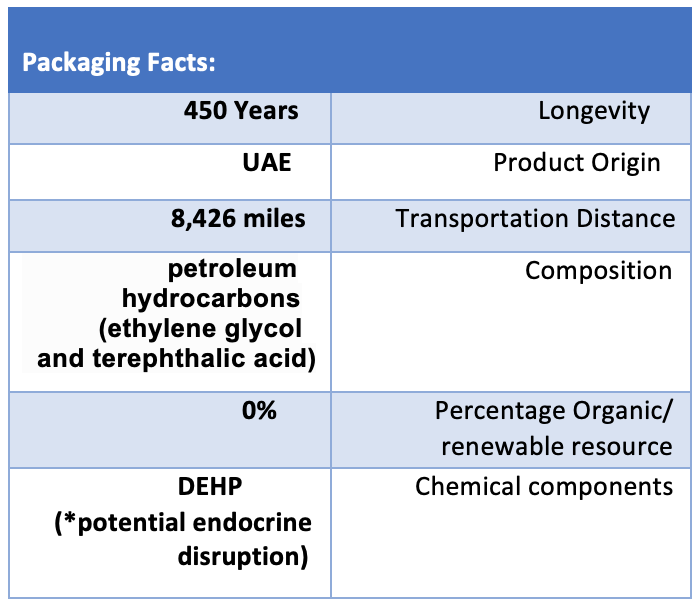What if we had ‘Packaging Facts’ similarly to how we have ‘Ingredients Facts’ mandated for products today? We know what is inside our food, but what about on the outside? These ‘Packaging Facts’ labels would be justified not only for the health of the consumer -due to potential chemical exposures from packaging- but also for ecological reasons, acknowledging packaging’s role in resource scarcity, global carbon footprints, increasing chemical exposure, conflict materials, and reliance on non-sustainable materials. This could help make more conscious and aware consumers and potentially help shift buying choices from packaging that is bad for health and the environment, to more local, nontoxic, renewable, and easily reused/circulated options. For instance, I would imagine a label to look and function something like this using the example of a PET plastic water bottle:
On the side of the PET bottle you’d see something like this (forgive me I am not a graphic designer) to break down the Facts of PET:

*Packaging Facts: A parody on ‘Nutrition Facts’
*Longevity = amount of time the material is estimated to remain in the environment.
*Origin = place of extraction of material (useful in determining conflict materials i.e. such as cobalt and also differentiating between supporting local and distant economies/economies of care or displaced economies)
*Transport = estimated transportation distance, for instance country of origin to port of entry, to show approximate carbon footprint. In this case I did a simple estimate between UAE and Los Angeles. This measurement can be helpful for those trying to source their foods locally, say within a 100mile radius. In this case, these transportation miles would really break the budget.
*Composition = to make people aware of the materials in their packaging. For instance, a product might be labeled ‘organic’ but the packaging could be chemically infused and even leeching into the product, therefore, not advisable. Also, as we try to transition from nonrenewable to renewable resources this will help make people aware of how purchases contribute to supporting these different systems.
*Percentage of Organic/renewable material: to what degree does this support sustainable or non-sustainable economy; restorative or nonrestorative practices.
*Chemical components/additives = specifically to help people become aware of the chemical components that make up certain products. The warning is like on cigarettes of what these additives can do (to help people be mindful of chemical exposure and potential risks). *Note: this is commenting on each additive, but not necessarily the cumulative factors of our pervasive chemical soup of modern society.
*QR Code : as recycling, upcycling, reuse, circular economy, and management are all contextually applicable, this allows customers to scan and see what is possible for this packaging in their area (say, within a 150mi radius). This code would also need to be updated for changes in laws/policy/practice. Additional information about packaging could be added here, for instance if the company of the product wants feedback on ‘likelihood of purchasing’ product packaged with a bamboo alternative, these sorts of feedback mechanisms could also be added, and more.
©️Katie Conlon Sept. 1, 2019
